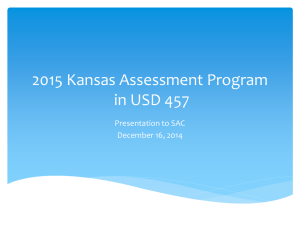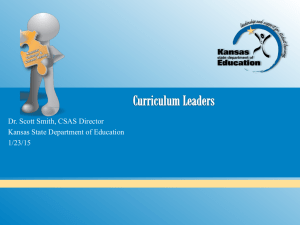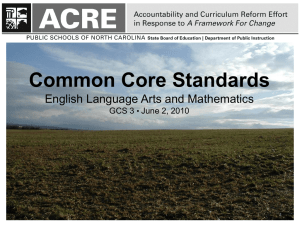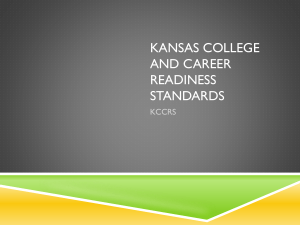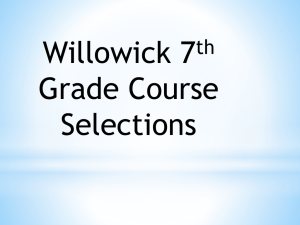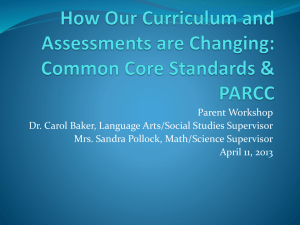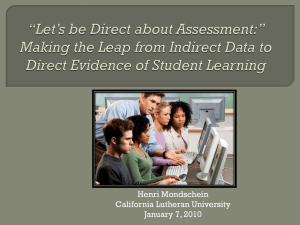Learning Forward Conference Presentation Slides
advertisement
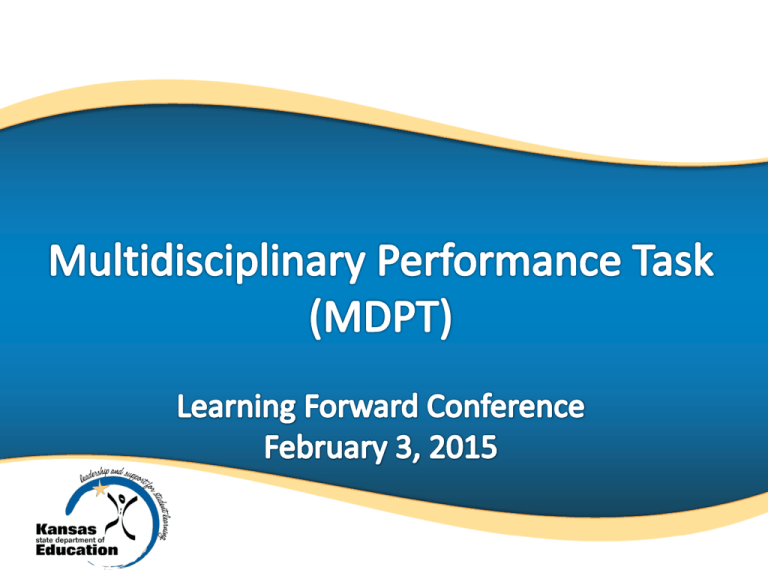
Move you from this… …To this! A performance task incorporating multiple disciplines which requires students to engage with texts, images, diagrams and other resources and then compose a narrative, informational/ explanatory text, or opinion (35)/argument (6-HS). What it IS: What it is NOT: • • • • An on-demand performance task aligned to current Kansas standards A “snapshot” of a student’s critical thinking and writing in an on-demand environment For 2015, a field test • • A week-long, process-focused writing task like the old Kansas Writing Assessment The opportunity for students to demonstrate the full range of their writing abilities For 2015, an assessment that will “count” for accountability at the district or state level The federal government requires each state to adopt standards in reading and math, and to administer a state assessment aligned to those standards, then submit the results of those assessments. Our assessment must also pass a federal peer review to prove that it is on-par with the assessments being developed by other assessment consortia. Standards in ELA, Science, and Mathematics are federally mandated. HGSS standards are not, but because of the emphasis on literacy across the content areas, and the desire to reduce the testing footprint, we are including HGSS in the MDPT. CETE HGSS Standards & Assessment Needs Multidisciplinary Performance Task Students ELA Writing HGSS Literacy Science Literacy The MDPT will seek to gain a score for two content areas: ELA and Science OR ELA and HGSS, depending on the year and grade. In some grades, there will only be an ELA score. ELA Standards Science Standards HGSS Standards What is a field test? The purpose of a field test is to determine whether items/prompts will produce valid and reliable information. Why is this necessary? We want to be confident in what a score on a particular assessment means, and in order to do that, the items need to be “tested” by students in real testing situations so that we can determine which items provide valid and reliable information and which do not. What does “field test” mean for the 2015 MDPT? • More prompts will be field tested than will be used in a single year. • For this year, Science texts and prompts will be field tested in 5th grade, even though this will be the final year or 4th graders to take the old Science assessment. • Grades that alternate between content area topics for the MDPT texts and prompts will field test prompts for different subject areas. A student could receive a Science prompt and texts, OR a prompt and texts from HGSS or ELA. Students will only take one, but subject areas won’t be assigned to a particular grade. 2015 Field Test Grade Topic Possible Writing Types 3 Variety OA IE N 4 Variety OA IE N 5 Science OA IE 6 Variety OA IE N HGSS OA IE N 7 Variety OA IE N 8 Science OA IE HGSS OA IE N 11 HGSS OA IE N Topics: Variety = A variety of topics will be included. For example, some tasks may be related to general interest topics, science, or social studies. Beginning in 2016, these tasks will count toward only the ELA score. Science = Science tasks will be OA or IE. Beginning in 2016, these tasks will count toward the ELA score. Beginning in 2017, these tasks will also count toward the Science score. HGSS = HGSS tasks will be N, OA, or IE but most commonly OA. Beginning in 2016, these tasks in grades 6 and 8 will count toward the HGSS score and the ELA score. The grade 11 task will count toward only the HGSS score. A more “Schmoker-esque” way to look at it, in terms of a resulting instructional focus: 2015 Field Test (and most likely beyond…) Grade ALL GRADES Topic ANY TOPICS WITHIN CONTENT AREAS THAT WOULD ENGAGE STUDENTS Possible Writing Types ANY WRITING THAT IS ADDRESSED IN A PARTICULAR CONTENT AREA’S STANDARDS Activity 1: Students will have one session to read/interact with and take notes about 2-3 resources, provided through KITE. Students will be given a set of guiding questions to help guide their reading, and to set them up for a successful composition session. Students will have the option of taking notes using paper/pencil OR taking notes using the note-taking tools in KITE. ALL students will have access to the Text-To-Speech (TTS), or ReadAloud feature within KITE, regardless of whether the student regularly receives this accommodation or not. Activity 2: Students will be given a prompt in which they will be asked to write ONE of the following: Narrative Expository/Informational piece Opinion/Argumentative piece Students will be provided a list of “reminders” aligned to the level 4 rubric descriptors to help ensure they adhere to the scoring criteria. Students will have access to both the resources and their notes from Activity 1, with the exception of highlighting done in the KITE system. If students need to make additional notes during Activity 2, they may do so. • • • Each session is approximately 30-50 minutes, but both are untimed, and students needing more time should be granted more time. Students may use graphic organizers, dictionaries, and other writing tools that are regularly made available during writing instruction. A teacher may not require or distribute these resources to students; students must choose and retrieve them on their own. A spell-check feature will be available in KITE, which students may turn on or off at their will. Resources will consist of combination (approximately 2-3) of short, related texts • Grades 3-5: about 750 words total • Grades 6-8: about 1000 words total • At least one graphic (e.g., chart, map, timeline, story arc) • Note: Some tasks vary slightly from the information above. For example, most HGSS-related tasks will not include a graphic. Students are not required to answer the guiding questions, and they will not be scored. Any paper/pencil notes students take must be collected each day and upon the student’s completion of the MDPT, the notes must be destroyed. • • • Developed this past fall by seven Kansas educators who have expertise in writing instruction Released in late December 2014 Intended to provide teachers a more clear picture of what the performance tasks will look like, and ALSO for possible instructional use Community.ksde.org/ela Lower right side of the page Read the guide first. …in fact, let’s go through it now together. It should… • follow the prompt and attempt to • • adhere to the descriptors in levels 3 and 4 on the MDPT rubrics. be approximately 1-3 paragraphs for grades 3-5, and approximately 3-5 paragraphs for grades 6-12. It is okay for students to exceed these guidelines. be able to be completed in a single sitting (the composition portion). It likely won’t… • look like a polished piece of writing. • • be comparable to longer pieces of writing completed during processfocused, multi-day assignments. take the student several hours to complete. Another answer to this is… …we will know more precisely as a result of the field test. Keep in mind: This is entirely new, created here in KS. This is a field test. • February 2014: Developed first at KSDE by content area consultants, informed by: • HGSS, Science, and ELA Standards • Existing drafts of HGSS performance task rubrics • Existing drafts of ELA performance task rubrics • 6+1 Trait Writing Rubrics • SBAC Performance Task Rubrics • • • • February-August 2014: Revisited and Revised 6-10 times in-house and with CETE. August 2014: Online review by volunteer educators, followed by webinars to review the feedback. August-September 2014: Revisited and Revised 2-3 times based on feedback. September 2014: Released to the field via KSDE web site. Notices were sent out on listservs. Rubrics community.ksde.org/ela community.ksde.org/science www.ksde.org → H → History, Government, Social Studies • • • Student work will be scored holistically. There are four performance categories on all rubrics. All grade bands have rubrics for: • Opinion/Argument • Informative/Expository • Narrative • Note: This is another way we can open up the curriculum…by not assigning a particular type of text to a particular grade. Two Tips: 1) It might be helpful to forget your past scoring experiences with the Kansas Writing Assessment. 2) Keep in mind that 2015 is a field test year, so scoring will likely be different this year than in the future. I will be talking only about scoring for 2015, the field test year. • Scoring for this year will be on a volunteer basis. To sign up to be a scorer: • Go to your test coordinator and ask to be assigned the role • • of “scorer” within the KITE system. If you ARE the test coordinator and want to sign up to score, find someone at or above your “level” to assign you the scorer role. If there is no one above you, call Lee Jones or Mark Stephenson at KSDE to assign you the role. Wait for further instructions regarding training. • • • Training for scoring will be completed online, beginning in April 2015. Scoring will be done online by individual scorers, following successful completion of training. Scorers may score as many student responses as they wish to score, up to 1000. • • A representative sample of student responses will be scored. Individual student scores will not be released this year. Do: • Focus on Instruction. • • • Organize instruction around the standards and best practices. Continue to teach students about developing a process for writing. Encourage students to process their reading by drawing pictures, charts, or making written notes about what they read. Don’t: • Focus writing curriculum around • • • practicing for the MDPT. Organize curriculum around the MDPT requirements. Format all writing assignments to be on-demand assignments. Worry about teaching students a formalized note-taking method. Suzanne Myers soertel@ksde.org (785) 296-5060 community.ksde.org/ela
